Occipital gamma activation during Vipassana meditation
- PMID: 20013298
- PMCID: PMC2812711
- DOI: 10.1007/s10339-009-0352-1
Occipital gamma activation during Vipassana meditation
Abstract
Long-term Vipassana meditators sat in meditation vs. a control rest (mind-wandering) state for 21 min in a counterbalanced design with spontaneous EEG recorded. Meditation state dynamics were measured with spectral decomposition of the last 6 min of the eyes-closed silent meditation compared to control state. Meditation was associated with a decrease in frontal delta (1-4 Hz) power, especially pronounced in those participants not reporting drowsiness during meditation. Relative increase in frontal theta (4-8 Hz) power was observed during meditation, as well as significantly increased parieto-occipital gamma (35-45 Hz) power, but no other state effects were found for the theta (4-8 Hz), alpha (8-12 Hz), or beta (12-25 Hz) bands. Alpha power was sensitive to condition order, and more experienced meditators exhibited no tendency toward enhanced alpha during meditation relative to the control task. All participants tended to exhibit decreased alpha in association with reported drowsiness. Cross-experimental session occipital gamma power was the greatest in meditators with a daily practice of 10+ years, and the meditation-related gamma power increase was similarly the strongest in such advanced practitioners. The findings suggest that long-term Vipassana meditation contributes to increased occipital gamma power related to long-term meditational expertise and enhanced sensory awareness.
Figures
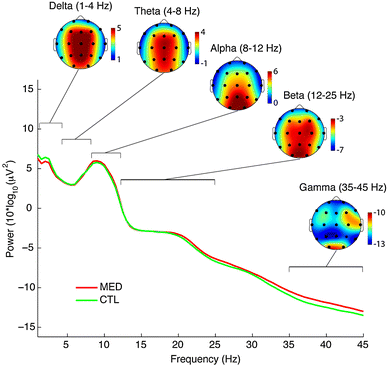
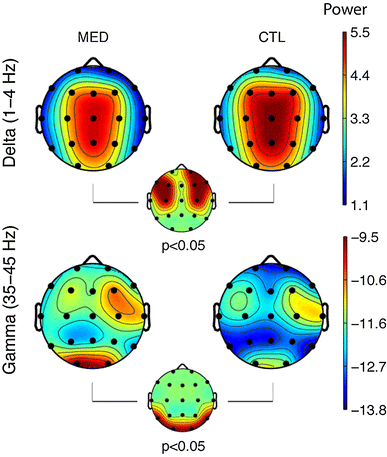
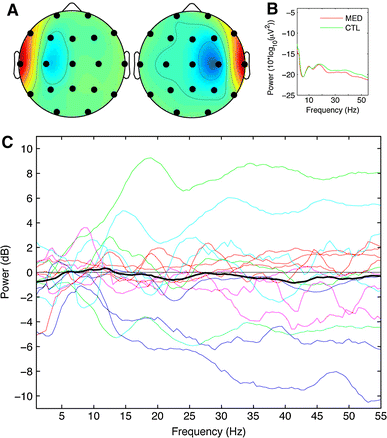
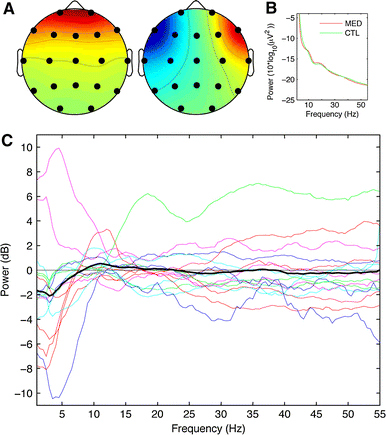
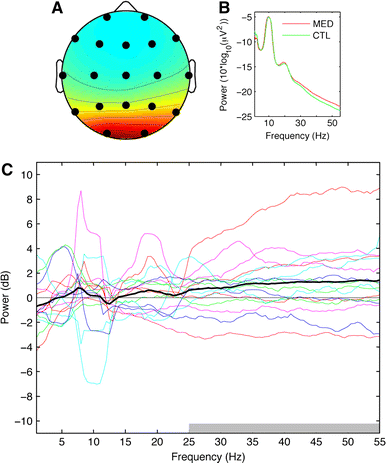
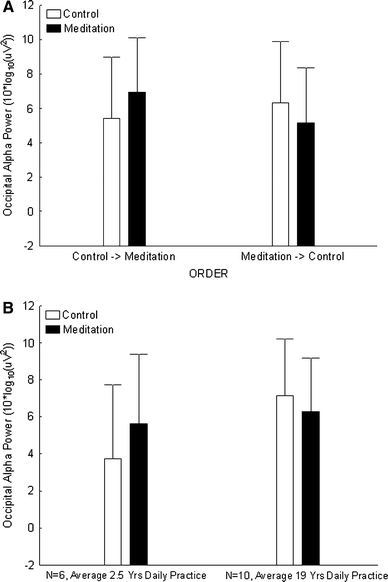
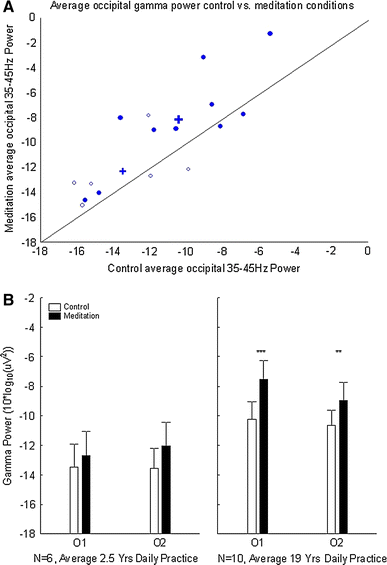
Similar articles
-
Event-related delta, theta, alpha and gamma correlates to auditory oddball processing during Vipassana meditation.Soc Cogn Affect Neurosci. 2013 Jan;8(1):100-11. doi: 10.1093/scan/nss060. Epub 2012 May 29. Soc Cogn Affect Neurosci. 2013. PMID: 22648958 Free PMC article.
-
State-trait influences of Vipassana meditation practice on P3 EEG dynamics.Prog Brain Res. 2019;244:115-136. doi: 10.1016/bs.pbr.2018.10.027. Epub 2019 Jan 22. Prog Brain Res. 2019. PMID: 30732834
-
Spectral power and functional connectivity changes during mindfulness meditation with eyes open: A magnetoencephalography (MEG) study in long-term meditators.Int J Psychophysiol. 2015 Oct;98(1):95-111. doi: 10.1016/j.ijpsycho.2015.07.006. Epub 2015 Jul 10. Int J Psychophysiol. 2015. PMID: 26166440
-
Mindfulness (Vipassana) meditation: effects on P3b event-related potential and heart rate variability.Int J Psychophysiol. 2013 Nov;90(2):207-14. doi: 10.1016/j.ijpsycho.2013.07.006. Epub 2013 Jul 24. Int J Psychophysiol. 2013. PMID: 23892096
-
A quantitative electroencephalographic study of meditation and binaural beat entrainment.J Altern Complement Med. 2011 Apr;17(4):351-5. doi: 10.1089/acm.2009.0691. Epub 2011 Apr 11. J Altern Complement Med. 2011. PMID: 21480784 Clinical Trial.
Cited by
-
Contrasting Electroencephalography-Derived Entropy and Neural Oscillations With Highly Skilled Meditators.Front Hum Neurosci. 2021 Apr 30;15:628417. doi: 10.3389/fnhum.2021.628417. eCollection 2021. Front Hum Neurosci. 2021. PMID: 33994976 Free PMC article.
-
Short-term meditation modulates EEG activity in subjects with post-traumatic residual disabilities.Clin Neurophysiol Pract. 2019 Feb 20;4:30-36. doi: 10.1016/j.cnp.2019.01.003. eCollection 2019. Clin Neurophysiol Pract. 2019. PMID: 30886941 Free PMC article.
-
Review of the Neural Oscillations Underlying Meditation.Front Neurosci. 2018 Mar 26;12:178. doi: 10.3389/fnins.2018.00178. eCollection 2018. Front Neurosci. 2018. PMID: 29662434 Free PMC article. Review.
-
Experienced mindfulness meditators exhibit higher parietal-occipital EEG gamma activity during NREM sleep.PLoS One. 2013 Aug 28;8(8):e73417. doi: 10.1371/journal.pone.0073417. eCollection 2013. PLoS One. 2013. PMID: 24015304 Free PMC article. Clinical Trial.
-
A Critical Analysis on Characterizing the Meditation Experience Through the Electroencephalogram.Front Syst Neurosci. 2020 Aug 7;14:53. doi: 10.3389/fnsys.2020.00053. eCollection 2020. Front Syst Neurosci. 2020. PMID: 32848645 Free PMC article. Review.
References
-
- Anand BK, Chhina GS, Singh B. Some aspects of electroencephalographic studies in yogis. Electroencephal Clin Neurophysiol. 1961;13:452–456. doi: 10.1016/0013-4694(61)90015-3. - DOI
-
- Anand BK, Chhina GS, Singh B. Studies on Shri Ramanand yogi during his stay in an air-tight box. Indian J Med Res. 1961;49:82–89. - PubMed
Publication types
MeSH terms
Grants and funding
LinkOut - more resources
Full Text Sources
Research Materials

